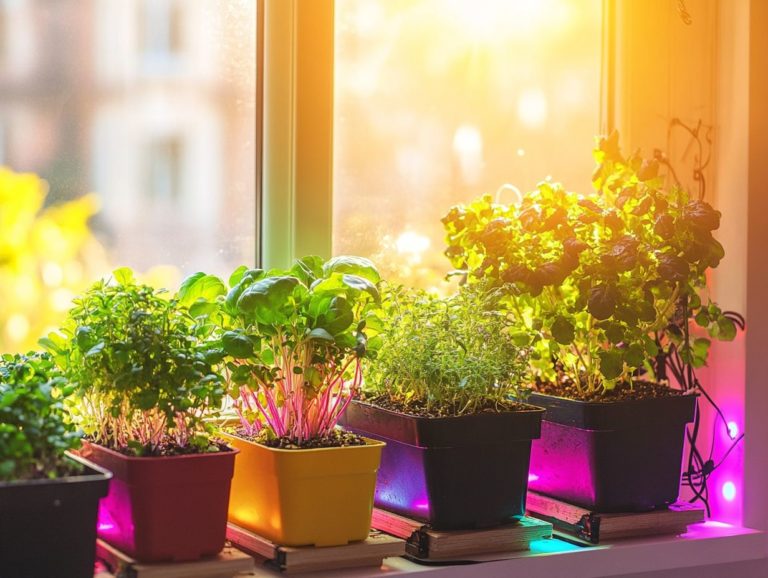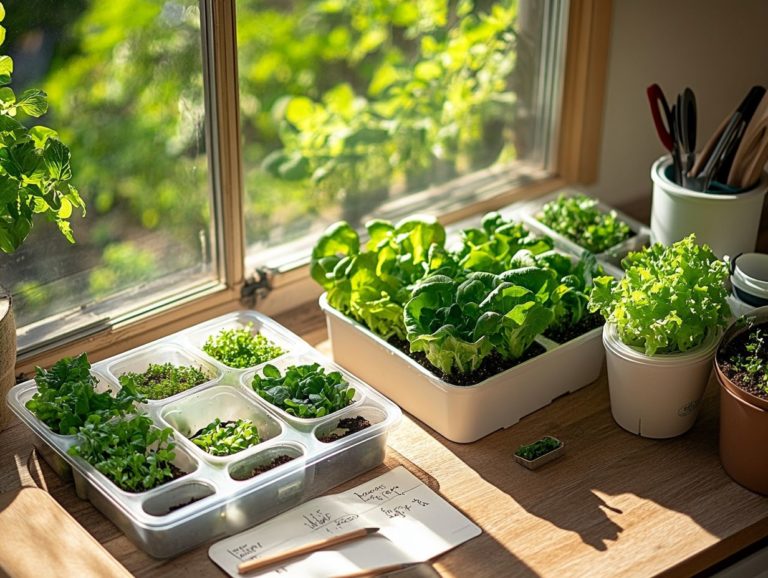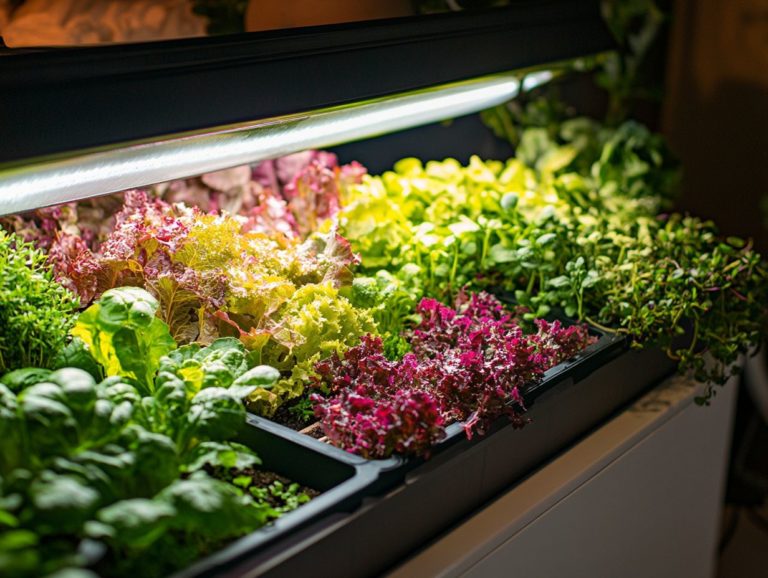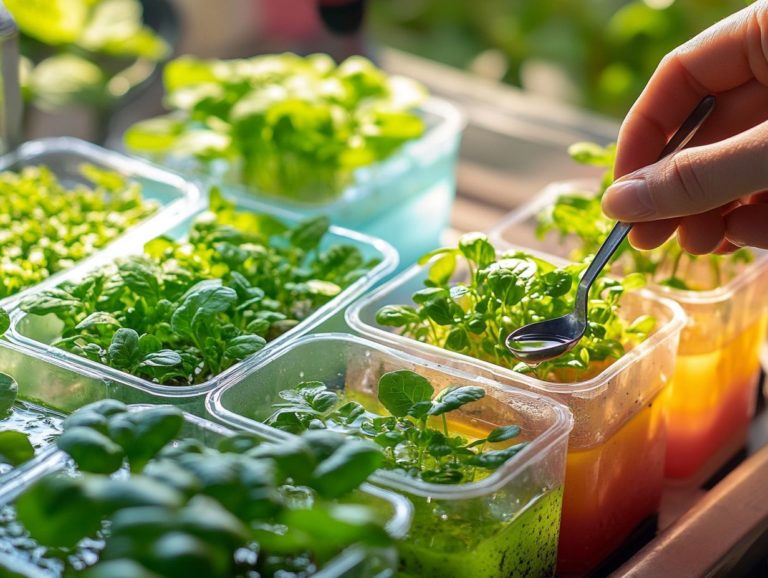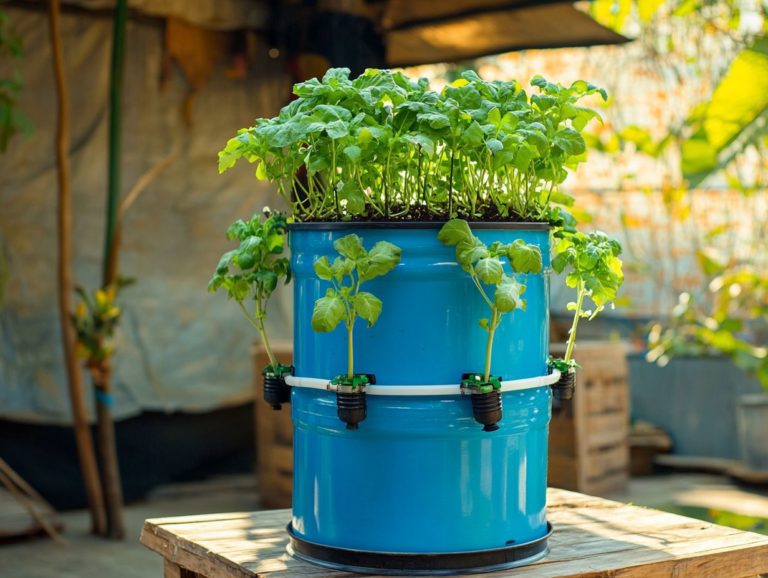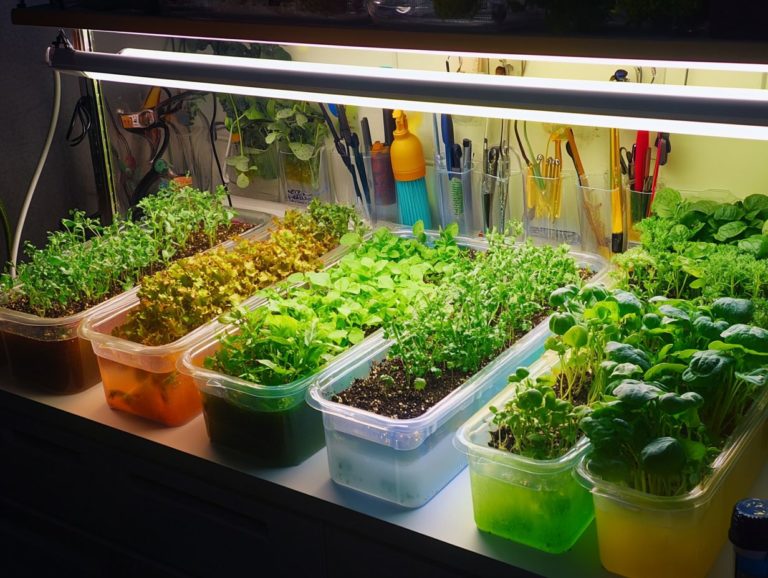Creating a Hydroponic Herb Garden at Home
Get ready to transform your gardening experience! Hydroponic gardening is changing the game, offering a space-saving way to grow your favorite herbs. This guide delves into the advantages of hydroponics compared to traditional gardening. It assists you in selecting the finest herbs for your indoor garden. You ll discover how to set up your system, maintain it with ease, and gather valuable tips for harvesting and preserving your fresh herbs.
Whether you re a seasoned gardener or a curious newcomer, this guide equips you with all the insights necessary to cultivate a flourishing hydroponic herb garden right in your home.
Contents
- Key Takeaways:
- Benefits of Growing Herbs Hydroponically
- Choosing the Right Herbs for Hydroponic Gardening
- Setting Up Your Hydroponic Herb Garden
- Maintaining Your Hydroponic Herb Garden
- Proper Watering and Nutrient Management
- Harvesting and Using Your Hydroponic Herbs
- Frequently Asked Questions
- 1. What is a hydroponic herb garden and how does it differ from a traditional garden?
- 2. What are the benefits of creating a hydroponic herb garden at home?
- 3. What supplies do I need to create a hydroponic herb garden at home?
- 4. How do I maintain a hydroponic herb garden at home?
- 5. Can any type of herb be grown in a hydroponic garden?
- 6. Are there any potential downsides to creating a hydroponic herb garden at home?
Key Takeaways:
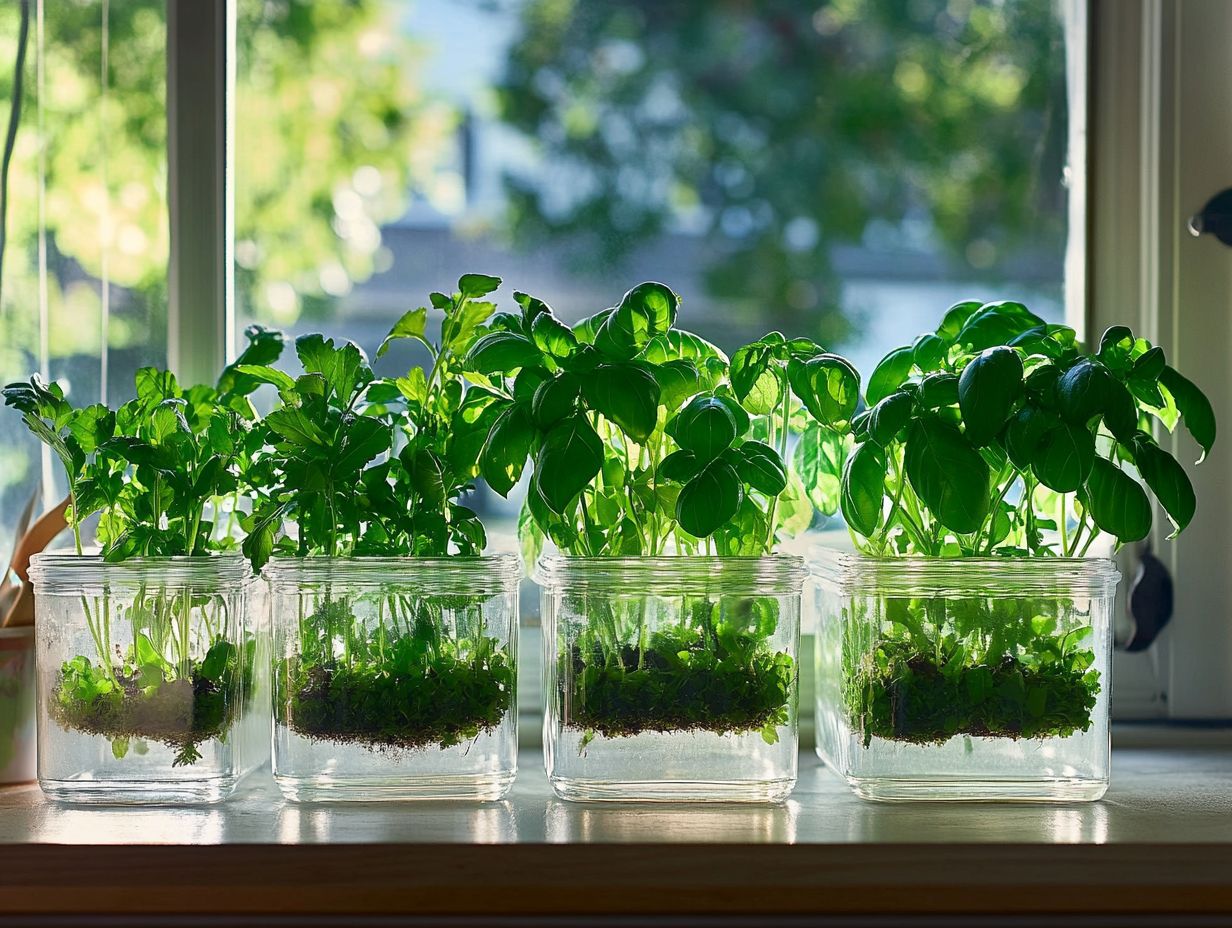
- Hydroponic gardening is a soil-free method of growing plants using a nutrient-rich solution, providing numerous benefits over traditional gardening.
- Some of the best herbs for indoor hydroponic gardening include basil, chives, mint, and parsley, which thrive in a controlled environment.
- To start a hydroponic herb garden at home, you will need basic equipment such as a grow tent, grow lights, and a reservoir for the nutrient solution.
What is Hydroponic Gardening?
Hydroponic gardening offers you a new method to grow plants without the need for soil. It relies instead on a nutrient-rich water solution to deliver all the essentials for thriving plant growth. This innovative technique enables year-round cultivation, making it perfect for anyone eager to produce fresh herbs and vegetables indoors or in tight quarters.
With a variety of setups available like the Kratky Method and Aerogarden systems, hydroponics not only optimizes your space but also conserves resources. If you’re interested in getting started, check out this guide on how to build a simple hydroponic system. This allows you to maintain a flourishing herb garden at home with minimal effort.
By forgoing soil altogether, hydroponic gardening greatly reduces the risk of soil-borne diseases and pests, creating a cleaner, disease-free space for your plants. This method also allows you to control factors such as pH levels and nutrient concentrations, which refer to the amount of essential minerals in the water, with precision. This leads to quicker growth and higher yields compared to traditional gardening practices.
Popular hydroponic systems like deep water culture and drip irrigation highlight the versatility of this approach, catering to both newcomers and experienced gardeners alike.
As the interest in sustainable practices continues to rise, many urban dwellers are embracing hydroponics as an effective solution for cultivating fresh produce in confined spaces. This ultimately enhances both food security and environmental sustainability.
Benefits of Growing Herbs Hydroponically
Growing herbs hydroponically presents an array of advantages that elevate your gardening experience. You can cultivate organic, fresh, and flavorful plants all year round, immune to the whims of outdoor conditions.
This method greatly reduces the space and resources required for traditional gardening, making it an attractive option for both novices and seasoned gardeners alike. With hydroponic systems, you gain enhanced control over nutrients and water, which minimizes waste and fosters healthier growth.
The result? A more abundant and rewarding harvest awaits you.
Advantages over Traditional Gardening
When you compare traditional gardening to hydroponics, the advantages become strikingly clear. Hydroponics requires less maintenance and allows you to grow fresh herbs in compact spaces, all while optimizing water and nutrients. Without soil, you create a cleaner environment and gain precise control over pH and nutrient levels, which can lead to accelerated growth and increased yields. Plus, the risk of pests and diseases those pesky nuisances of soil-based gardening is significantly reduced.
For urban dwellers, hydroponic systems for home gardeners are a game changer, enabling you to cultivate your own food even in the tiniest of spaces like balconies or rooftops. This innovative method allows for year-round cultivation, free from the limitations of seasonal changes that can hinder traditional gardening. With a structured environment, your hydroponic plants can thrive without the competition of weeds, ensuring better resource allocation.
This approach also aligns beautifully with sustainable practices. By using less water and steering clear of chemical pesticides, you embrace a more eco-friendly gardening method that resonates with today s agricultural trends.
Ready to dive in? Gather your supplies and start your hydroponic herb garden today!
Choosing the Right Herbs for Hydroponic Gardening
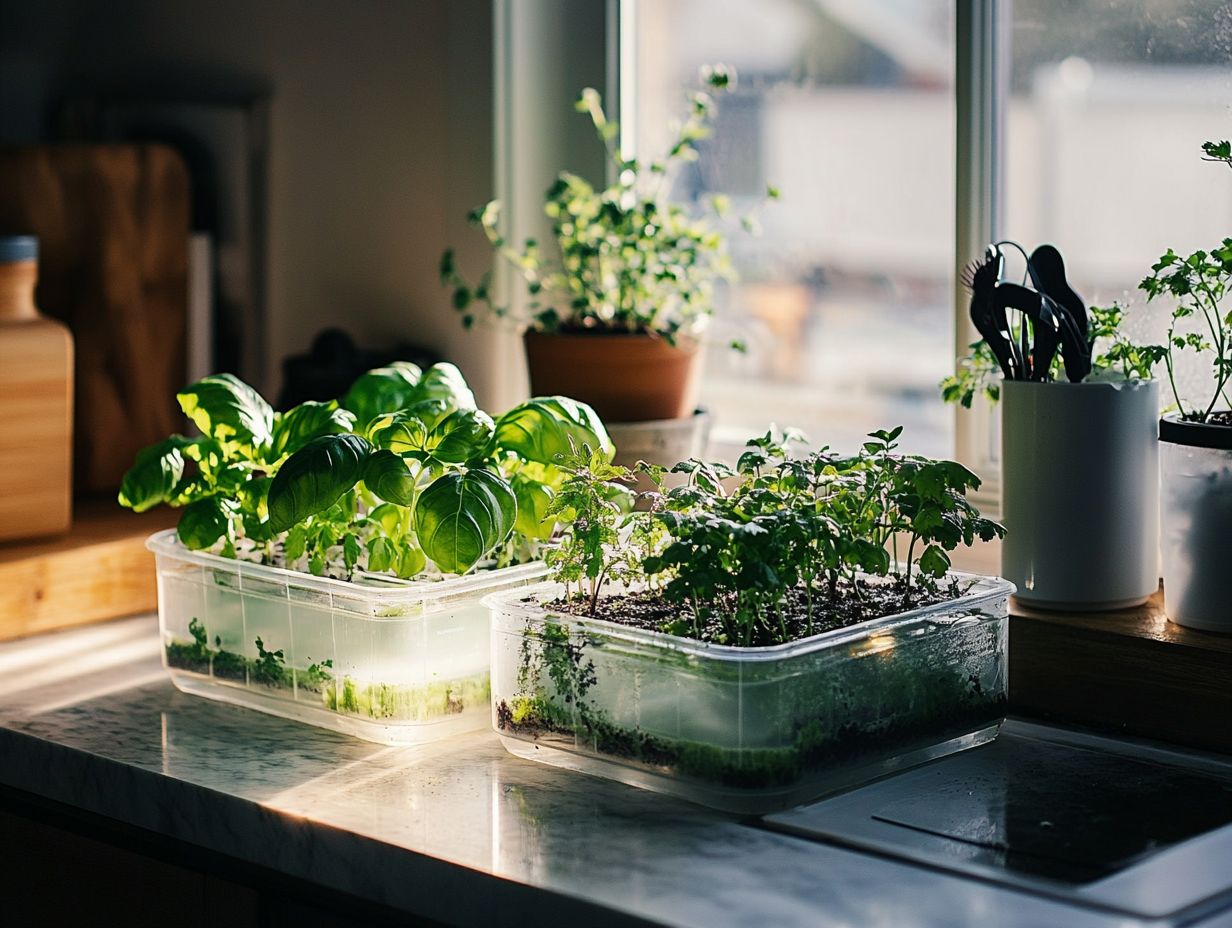
Selecting the right herbs for your hydroponic garden is crucial to achieving success. Popular choices like basil, chives, oregano, thyme, sage, and cilantro all flourish in indoor settings.
Each herb has its own set of growth requirements and distinct flavors. It s vital to align your hydroponic system’s capabilities with the specific needs of the plants you choose.
Understanding the growing season and optimal light conditions is crucial for improving productivity in your herb garden.
Best Herbs for Indoor Growing
When diving into indoor hydroponic gardening, some of the best herbs to cultivate are basil, chives, thyme, and cilantro. These herbs adapt exceptionally well to hydroponic systems.
By utilizing net pots and rockwool as your growing media, you can create an environment where these herbs thrive, ensuring optimal growth conditions.
Indoor gardening grants you access to fresh produce year-round and allows you to experiment with diverse herbs that can elevate your dishes.
Basil, with its aromatic leaves, adds a sweet and slightly peppery kick to salads and sauces. Meanwhile, chives contribute a subtle onion flavor that enhances a variety of recipes.
Thyme, with its earthy undertones, pairs beautifully with roasted meats and vegetables. Cilantro introduces a fresh, zesty twist, particularly shining in salsas and Asian cuisine.
Each of these herbs has unique light and temperature preferences, creating vibrant mini-ecosystems within your indoor garden. By providing the right nutrient solutions and adjusting pH levels as necessary, you can encourage robust growth, yielding flavorful and aromatic herbs.
Setting Up Your Hydroponic Herb Garden
Setting up your hydroponic herb garden can be an exciting project, enabling you to cultivate a sustainable oasis of fresh herbs at home.
To embark on this journey, gather essential equipment and supplies, such as a suitable hydroponic system, an effective light source, a water testing kit, and quality nutrient solutions.
With the right tools and thoughtful planning, you can create a thriving herb garden that flourishes indoors or in compact spaces, no matter the season.
Equipment and Supplies Needed
To successfully establish your hydroponic herb garden, you need specific equipment and supplies. This includes a hydroponic system, an air pump (a device that adds oxygen to the water), a water testing kit, net pots, and a growing medium like rockwool.
Each of these components plays a crucial role in ensuring your plants receive the necessary water, nutrients, and air for healthy growth.
Investing in high-quality equipment can significantly enhance the productivity and efficiency of your hydroponic setup.
The hydroponic system serves as the backbone of your garden, facilitating the flow of nutrient-rich water to the roots of your plants. An air pump is critical, as it oxygenates the water, promoting root respiration and vigorous growth.
Additionally, having a reliable water testing kit allows you to monitor pH and nutrient levels regularly critical factors for optimizing plant health. Net pots act as sturdy containers for your plants, enabling roots to access the nutrient solution freely.
Choosing a growing medium like rockwool offers support while retaining moisture, ensuring the roots thrive without suffocation. Together, these elements create a flourishing environment for herb cultivation.
Maintaining Your Hydroponic Herb Garden
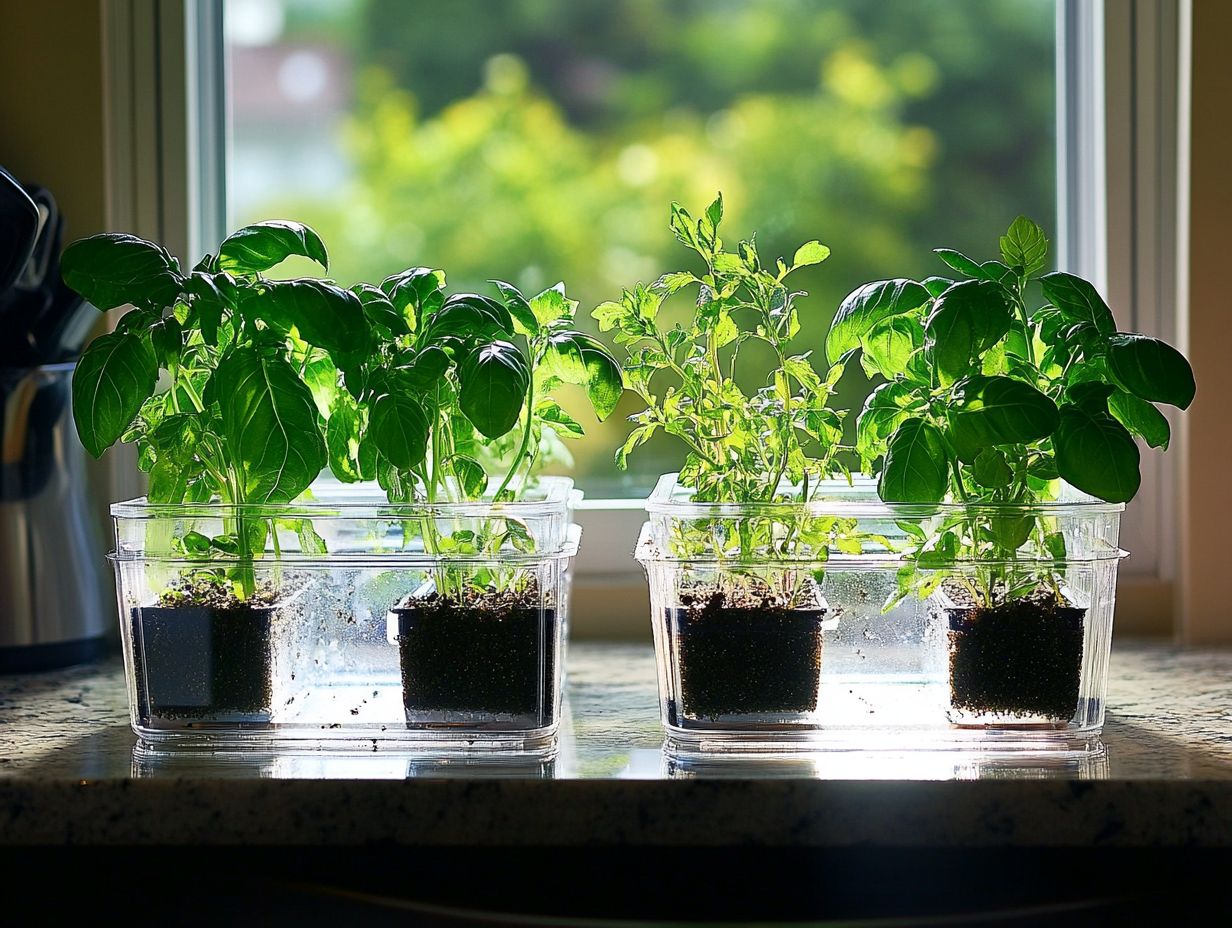
Maintaining your hydroponic herb garden is essential for fostering the healthy growth of your plants. This involves mastering proper watering and nutrient management techniques.
Regularly monitoring water levels and nutrient concentrations gives you the power to adjust conditions. This ensures optimal health for your herbs while preventing issues such as algae growth or nutrient deficiencies.
By establishing a consistent maintenance routine, you’ll keep your hydroponic system operating seamlessly and your plants thriving beautifully.
Proper Watering and Nutrient Management
Proper watering and nutrient management are essential components of successful hydroponic gardening that directly impact your plants’ health and yield. By regularly testing water pH and nutrient levels, you can ensure that your herbs receive the precise amounts of water and nutrients critical for their growth.
Taking a thoughtful approach to these practices will elevate the quality of your herbs and enhance the efficiency of your hydroponic system.
Hydroponic systems require a delicate balance; over or under-watering can cause stress or disease in your plants. Utilizing tools like EC (Electrical Conductivity) meters and pH pens allows you to make timely adjustments to the nutrient solution, vital for maintaining optimal conditions.
Understanding the specific needs of different plant species will guide you in determining watering frequency and nutrient concentrations.
Incorporating techniques like nutrient cycling and regular system cleaning promotes healthier growth. Ultimately, these meticulous strategies maximize your yields and ensure sustainability in your hydroponic practices.
Harvesting and Using Your Hydroponic Herbs
Harvesting and using your hydroponic herbs is a rewarding experience that lets you savor the fruits of your labor while elevating your culinary creations with fresh flavors.
Understanding the optimal timing and techniques for harvesting your herbs can significantly enhance both their flavor and yield, whether you choose to use them immediately or preserve them for later.
By embracing proper harvesting methods, you ensure the ongoing vitality of your plants and maintain a consistent supply of fresh, vibrant produce.
Tips for Harvesting and Preserving Fresh Herbs
To truly maximize the flavor and longevity of your fresh herbs, embrace effective harvesting and preserving techniques that ensure top-notch quality.
By cutting at just the right moment and storing your herbs under optimal conditions, you can significantly enhance their flavor profile, allowing you to savor them for an extended period.
Techniques like drying or freezing not only preserve their taste and aroma but also make them conveniently available for your culinary endeavors down the line.
Harvest your herbs during mid-morning, once the dew has evaporated, to capture the highest essential oil content, resulting in more vibrant flavors.
For trimming, using sharp scissors or pruning shears is a smart move; it prevents bruising and encourages healthy regrowth.
For preservation, consider air-drying in a well-ventilated space or using an airtight container for freezing to lock in those aromatic qualities.
And don t overlook the importance of labeling your preserved herbs. This small step can save you valuable time and enhance your cooking experience, giving you quick access to those delightful homegrown flavors whenever inspiration strikes.
Frequently Asked Questions

1. What is a hydroponic herb garden and how does it differ from a traditional garden?
A hydroponic herb garden is a method of growing plants using water and nutrient solutions, without the use of soil. This differs from a traditional garden where plants are grown in soil and receive nutrients from the soil. Hydroponics allows for more control over nutrient delivery and can result in faster growth rates.
2. What are the benefits of creating a hydroponic herb garden at home?
Creating a hydroponic herb garden at home offers many benefits, including faster growth rates, higher yields, and the ability to grow plants in smaller spaces. Hydroponic gardens require less maintenance and can be grown indoors, making them accessible year-round.
3. What supplies do I need to create a hydroponic herb garden at home?
To create a hydroponic herb garden at home, you will need a water-tight container, a pump, a nutrient solution, growing medium, and herbs or seeds to plant. You may also need a grow light if you are growing your garden indoors.
4. How do I maintain a hydroponic herb garden at home?
Maintaining a hydroponic herb garden is relatively easy. Keep an eye on the water level and nutrient solution.
Periodically clean and replace the growing medium. Also, check the pH level, which measures how acidic or alkaline the water is, and adjust if necessary.
5. Can any type of herb be grown in a hydroponic garden?
Yes! Most herbs thrive in a hydroponic garden. Some popular choices include basil, parsley, cilantro, thyme, and mint.
It’s wise to research each herb’s specific needs before planting.
6. Are there any potential downsides to creating a hydroponic herb garden at home?
The initial setup cost can be a downside. This method may also require more monitoring and care than traditional gardening.
Some people believe that herbs grown in soil taste better. However, the convenience of growing fresh oregano and chives indoors often makes hydroponics worth it!

